How To Get Rid Of Bumps On Skin
When you check your makeup in the mirror, only to spot a giant you-have-no-idea-what bump staring back at you, it's tempting to go IN on your face. But experts agree that when it comes to most face bumps and pimples under skin, a hands-off approach is most definitely best.
"Popping anything causes your skin to physically break apart, making it more susceptible to infection and an even bigger problem than what was originally there in the first place," says Dendy Engelman, MD, board-certified dermatologist at Manhattan Dermatology and Cosmetic Surgery in New York City. You're also pretty-much guaranteeing scarring and a drawn-out healing process if you don't resist the pop, says Noelani Gonzalez, MD, director of cosmetic dermatology at Mount Sinai West.
The best move is to stock up on derm-approved, over-the-counter skincare products—or let professionals handle it in their offices with skin-safe lasers and gadgets you don't have access to at home. And the smartest treatment will depend on what exactly is causing your annoying skin issues—whether it's a hard pimple underneath the skin or tiny white bumps on your face.
Here, all of the details you need on 12 common bumps—and a friendly reminder that you definitely should not be picking them:
1. Cystic Acne Pimples

Shutterstock
Cystic pimples occur very deep under the skin's surface, forming a red, tender nodule that's not only painful but much harder to treat with OTC meds. "The inflammation that accompanies cystic acne can hinder the healing process and often lead to permanent scarring that's impossible to eliminate," says Dr. Engelman.
Picking at these bumps under the skin won't help either. "The cysts occur so far beneath the skin that you won't even come close to reaching the bump, and you'll be left with a bloody spot," says Joel Schlessinger, MD, a board-certified dermatologist.
This content is imported from {embed-name}. You may be able to find the same content in another format, or you may be able to find more information, at their web site.
The cause: "Cystic acne is caused by hormonal fluctuations and acne bacteria," says Dr. Schlessinger. "High hormone levels trigger an overproduction of oil, causing pores to swell. When this oil cannot reach the skin's surface, it ruptures underneath and causes inflammation to spread to the surrounding tissue." Other causes include bacteria in hair follicles and slowed cell turnover in acne patients that lead to keratin buildups in pores, says Dr. Gonzalez.
The treatment: Instead of going at it with your fingers, book an appointment with your dermatologist, who can properly treat the situation (usually in the form of a cortisone shot to instantly kill the swelling) and may even be able to save you from scarring altogether.
2. Milia

Shutterstock
Ever notice how those tiny white bumps on your face (aka milia) refuse to pop no matter how hard you try? Well, rest assured. They are truly un-poppable—at least without a dermatologist or esthetician's help.
The cause: Milia are not actually filled with dirt, oil, or grime. They are tiny, harmless cysts that occur when dead skin cells get trapped under your skin, says Dr. Schlessinger. "Picking at them often has little to no effect, and attempting to pop them will likely leave your skin red, irritated, and inflamed, with the milia still intact," says Dr. Schlessinger. Ouch.
➡ Join WH Stronger today and get unlimited access to digital content, exclusive workouts, and more!
The treatment: "If it's bothering you, schedule an appointment with your dermatologist, who will likely extract with a heated, sterilized tool," says Dr. Engelman. You can also use a retinoid cream to help smooth them out faster, although milia generally clear up on their own.
3. Ingrown Hairs
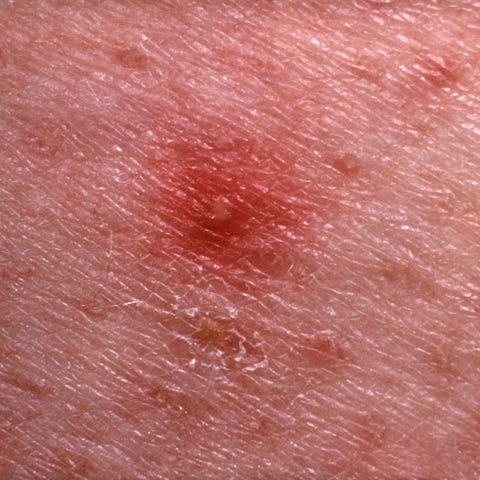
Getty / Biophoto Associates
Frustrating? Extremely. Worth picking—even if you just shaved your bikini line? Absolutely not.

CeraVe Hydrocortisone Anti-Itch Cream
The cause: "Ingrown hairs occur when the hair shaft becomes trapped beneath the skin's surface," says Dr. Schlessinger. "The red bumps that follow are often itchy and inflamed, but it's never a good idea to use tweezers or manual force to pluck them." Squeezing them will only make the inflammation and irritation worse, he adds. (Hello, unsightly red marks that last for months.)
The treatment: Apply hydrocortisone, which reduces redness, itchiness, and irritation—and wash the affected area with an exfoliating cleanser to help the hair reach the skin's surface. If the painful bumps persist, Dr. Gonzalez says you can go to a dermatologist who will nick the skin and remove the hair or inject it with steroids to reduce the inflammation. Pro tip so you don't have to deal with them at all: Exfoliate before you shave, and shave in the direction your hair grows instead of against it.
4. Skin Tags
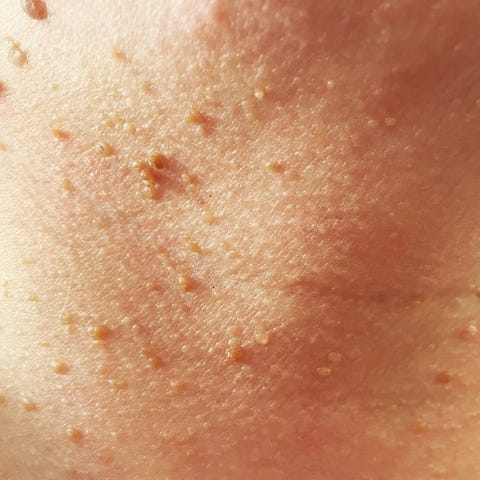
KeskiHeikkila Shutterstock
"Skin tags are extra growths of skin that typically occur on the neck and underarms," says Joshua Zeichner, MD, director of cosmetic and clinical research in dermatology at Mount Sinai Hospital. But there are a few reasons why you shouldn't pick at the small bumps. Namely, skin tags are made from flesh, and attempting to remove them will cause pain and bleeding, says Dr. Zeichner. It could also increase your risk of infection.
The cause: "They often occur in areas of friction, like by the neck, underarms, and groin, and they are thought to be caused by skin rubbing on skin or on clothing," says Bruce Katz, MD, a dermatologist in New York City. Dr. Gonzalez typically sees skin tags on her overweight patients or those who wear a lot of jewelry.
The treatment: This one's definitely a job for pros. "A professional can remove skin tags by freezing them off (a technique using liquid nitrogen known as cryotherapy), lightly burning them off with cautery, or surgically removing them by snipping them off," says Dr. Gonzalez. And if your skin tags are large enough to interfere with your daily life, your insurance company might even take the bill off your hands, says Dr. Zeichner.
5. Cold Sores

Shutterstock
Unless you're looking to inspire a whole army of these bad boys, don't even think about touching them—no matter how much that cold sore looks like a pimple. "Picking at cold sores could very easily lead to the formation of another sore," says Dr. Schlessinger. "Popping them releases a blister-like fluid that contains the same virus and can easily spread to other areas, including someone else's face."
The cause: The herpes simplex virus type 1 (HSV-1) and type 2 (HSV-2) are to blame for cold sores, and they're crazy-common, says Dr. Gonzalez. Seriously—50 to 80 percent of U.S. adults have oral herpes.
The treatment: Small sores can heal on their own with the help of OTC treatments. But if you notice cold sores popping up more frequently (or spreading to larger areas), Dr. Gonzalez says you should see a doctor for professional help for more aggressive medication and, if you have sores more than six times per year, preventative medication.
6. Dermatosa Papulosa Nigra (DPN)

Getty Images
These brown or black bumps look like moles and occur on the face and neck primarily happen in skin of color. Dermatologist Mona Gohara, MD, says, "There's no concern except those bothered by them cosmetically."
The cause: It's genetic. "There is no known cause at this point, but we know it runs in families," says Dr. Gohara.
The treatment: Again, there's no harm in these marks, but if you don't like the look of them, you can get in-office removal treatments. According to Skin of Color Society, that includes "scissor excision, shave excision, cryosurgery, electrodessication, curettage, dermabrasion, and laser removal." Just know with deeper skin tones, there's a risk of these procedures triggering skin coloration problems so be sure to create a post-care plan with your derm.
7. Keratosis Pilaris
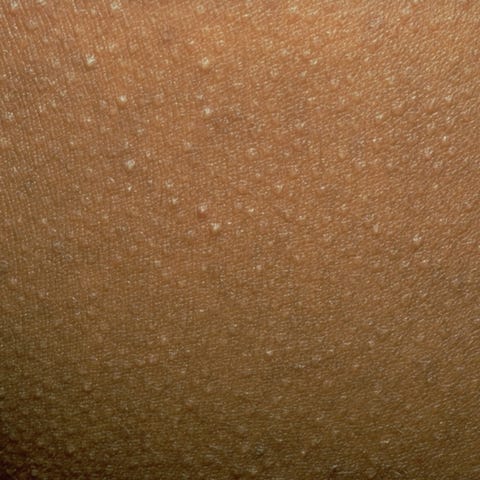
American Academy of Dermatology
"Squeezing or picking at these lesions causes worsening effects like redness and the potential for scarring as well," says Dr. Engelman.

Amazon
AmLactin Daily Moisturizing Body Lotion
The cause: Often referred to as "chicken skin," this genetic condition is caused by a buildup of keratin—the protein that protects skin, hair, and nails from infection and other harmful environmental toxins. "The buildup forms a plug that blocks the opening of a hair follicle," Dr. Engelman adds.
The treatment: Instead of picking, use a chemical exfoliant that has salicylic acid and glycolic acid, or products such as AmLactin to calm the inflammation and gradually smooth out the bumps over time, Dr. Gonzalez says. "If that doesn't work, see a dermatologist or an esthetician who can properly treat you," recommends Dr. Engelman. Treatment options include the topical medication tretinoin (a.k.a. Retin-A) to exfoliate the area, pulsed dye laser to treat redness, and chemical peels, Dr. Gonzalez adds.
8. Blackheads And Whiteheads
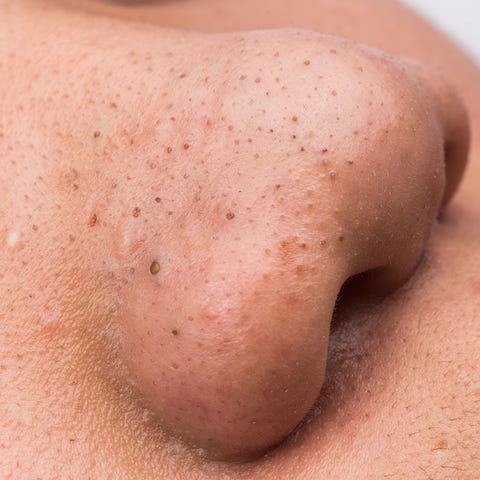
Shutterstock
These might be some of the most commonly popped bumps—but keeps your hands off if you can.
The cause: "Blackheads consist of the same thing as whiteheads—pores that become clogged with oil—except the oil has oxidized after being exposed to the air, giving it a black or brownish hue," says Dr. Schlessinger. "Squeezing them can force the bacteria even deeper and causes trauma to the skin."

Amazon
Differin Adapalene Gel 0.1% Acne Treatment
Differin amazon.com
$28.23
The treatment: The best ingredients for dealing with blackheads are salicylic acid and retinol. These exfoliants promote cell turnover, preventing dead skin cells from plugging up your pores.
To work the oil and dirt out without picking at your blackheads or applying pressure, use an over-the-counter exfoliant like Differin Gel. "It will work to bring the blackhead to the skin's surface, leaving you with a fresh face in just days," says Dr. Engelman.
And look for makeup and skincare products that are oil-free and non-comedogenic, to ensure that what you're using on your face won't contribute to any future bumps.
9. Seborrheic Keratoses

whitemay Getty Images
Dr. Zeichner says seborrheic keratoses are rough brown bumps that typically occur on areas that get a lot of sun exposure, like the face, chest, and back. They're totally benign, Dr. Gonzalez says
This content is imported from {embed-name}. You may be able to find the same content in another format, or you may be able to find more information, at their web site.
, but they can get in the way since they can get caught in clothing and feel scaly.
The cause: "These are solid growths of extra skin that build up on the surface of your body," says Dr. Zeichner. Sun exposure doesn't help, but even if you lather up with sunscreen daily (which you should!), these bumps might still be in the cards for you since they're genetic.
The treatment: Instead of trying to pop them, Dr. Zeichner recommends visiting your dermatologist if they become irritated or inflamed—your derm may even be able to get treatment covered through your insurance.
"If you are bothered by the appearance, speak to your dermatologist about a treatment called Eskata, which is the only FDA approved treatment for them," advises Dr. Zeichner. The treatments cost about $375 per session and typically require two sessions to work; each session treats four to five spots. Otherwise, you can opt for cryotherapy to freeze them off or have them gently burned off, adds Dr. Gonzalez.
10. Lipomas

Getty Images
A lipoma is a fatty deposit underneath the skin that might feel like a cystic pimple. They're non-cancerous and generally harmless, although they can become painful if they grow too big.
The cause: Lipomas are often genetically linked, so you can thank your parents if you notice one start to pop up, says Dr. Gonzalez.
The treatment: Even though Dr. Pimple Popper "pops" lipomas for her clients on the reg, you should not give it a try at home. Breaking open your skin will make it red, angry, and potentially let bacteria into the area. Your best option is to have a dermatologist remove it by burning it off or taking a laser to it to reduce scarring.
11. Cherry Angiomas

PobladuraFCG Getty Images
These bright red benign bumps are made up of tiny blood vessels. They tend to pop up on the face, chest, belly, and back.
The cause: Their cause is unknown, but there is a genetic component that might make you more prone to getting them.
The treatment: Considering these are filled with blood, popping them is definitely not the move. However, removal is pretty straight forward, Dr. Gonzalez promises. A trip to the dermatologists office for a laser or a cautery treatment will leave you bump and scar-free.
12. Sebaceous Cysts
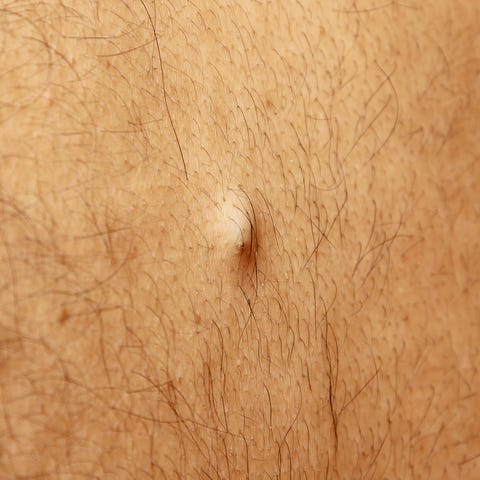
anayas Getty Images
Another Dr. Pimple Popper fave, these skin-colored bumps are full of a yellow cheese-like material that Dr. Gonzalez says you probably won't want to see or get a whiff of. And though they're typically benign and asymptomatic, these can sometimes become painful if they're inflamed, infected, or get ruptured, she adds.
The cause: These random build-ups of keratin, which looks like a pimple under the skin, pop up on areas of the body with a high volume of oil glands.
The treatment: "Treatment-wise, you have a few options," Dr. Gonzalez says. You can have your derm inject them with steroids to help the inflammation go down and reduce the bump's appearance, or your doctor can perform surgery to remove the keratin-filled capsule inside, which is a pretty good option since the cyst is likely to become inflamed again unless it's totally removed.
13. Sebaceous Hyperplasia
This content is imported from Instagram. You may be able to find the same content in another format, or you may be able to find more information, at their web site.
These small yellowish bumps that pepper the forehead or center of the face are super-common. They tend to appear with age and are often mistaken for pimples or skin diseases.
The cause: While totally harmless, the bumps are caused by an overgrowth of oil glands on the face. Unfortunately, there are no signs or symptoms to look out for, you'll just see 'em when you see 'em (sorry!).
The treatment : If you're bothered by their appearance and long for the days when your skin was smooth and clear, Dr. Gonzalez says dermatologists can lightly burn these doughnut-looking bumps off with electrocautery, laser them off, or freeze them off with cryotherapy.
This content is created and maintained by a third party, and imported onto this page to help users provide their email addresses. You may be able to find more information about this and similar content at piano.io
How To Get Rid Of Bumps On Skin
Source: https://www.womenshealthmag.com/beauty/a19953557/bumps-you-should-never-pop/
Posted by: williamswelice.blogspot.com

0 Response to "How To Get Rid Of Bumps On Skin"
Post a Comment